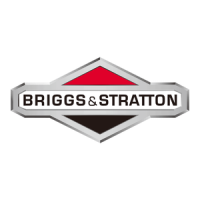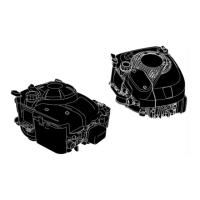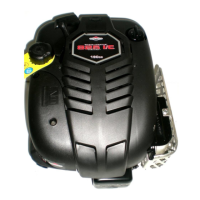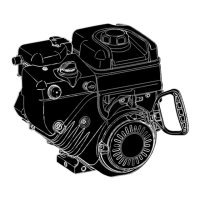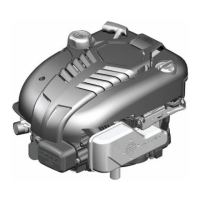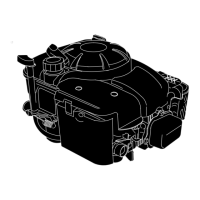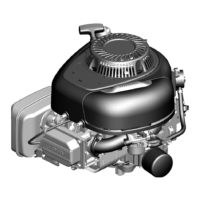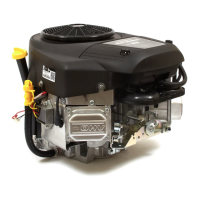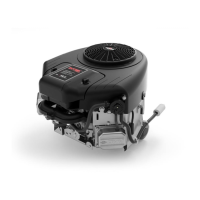
Do you have a question about the Briggs & Stratton 440000 Intek Extended Life Series and is the answer not in the manual?
| Displacement | 344 cc |
|---|---|
| Fuel Type | Gasoline |
| Starting System | Recoil |
| Cylinder Configuration | Single Cylinder |
| Cooling System | Air Cooled |
| Oil Type | SAE 30 |
| Engine Type | OHV |
| Oil Capacity | 1.5 qt |
| Spark Plug Gap | 0.030 in |
| Warranty | 2 years |
Explains symbols used on the engine for hazard identification and operation.
Warns against using engines on specific vehicles due to potential serious injury or death.
States engine exhaust contains chemicals known to cause cancer, birth defects, or reproductive harm.
Warns that starting the engine without oil will cause irreparable damage and void the warranty.
Identifies the location for crucial engine identification numbers (Model, Type, Code).
Locates the dipstick and fill point for engine oil.
Identifies the air cleaner for intake and the oil filter for lubrication system.
Covers fuel pump, fuel filter, and electric starter components.
Warns about extreme flammability and explosion risks associated with gasoline.
Alerts to the dangers of carbon monoxide gas produced by engines.
Warns about ignition risks from sparking during engine starting.
Explains the danger of starter cord retraction (kickback) and potential injuries.
Warns of entanglement hazards from moving engine parts, leading to amputation or laceration.
Alerts to severe burn risks from hot engine parts and fire risk from debris.
Outlines critical safety steps before working on the engine, like disconnecting power.
Details safe procedures for checking for spark, avoiding removal of the spark plug.
Step-by-step guide for starting the engine, including oil check and choke operation.
Advises keeping all components in place for proper engine operation.
Explains the function of the oil pressure switch and related warnings.
Warns against stopping the engine by choking the carburetor to prevent damage.
Lists common causes and solutions for an engine failing to start.
Provides troubleshooting steps for engines exhibiting smoking or rough running issues.
Reinforces safety checks before starting the engine and during refueling.
Warns about consequences of overfilling the engine crankcase with oil.
Advises on keeping the spark plug side up when tipping the engine for maintenance.
Specifies the amount of oil required for the engine with and without an oil filter.
Advises on the type, viscosity, and brand of oil to use for optimal engine performance.
Explains how oil viscosity affects performance and consumption in air-cooled engines.
Provides a step-by-step guide on how to correctly check and add engine oil.
Specifies the type of gasoline to use and warns against certain additives like Methanol.
Warns about potential damage from high concentrations of alcohol or ether in gasoline.
Details the process for safely adding fuel to the engine's tank.
Reinforces crucial safety measures to follow when refueling the engine.
Explains responsibilities for emission control system maintenance and authorized service.
Provides a table outlining recommended maintenance tasks at different intervals.
Lists critical safety precautions before performing any maintenance on the engine.
Highlights safety steps like disconnecting spark plug wires before changing oil.
Advises on proper and safe disposal methods for used engine oil.
Details the process for replacing the engine's oil filter at specified intervals.
Explains the role of the oil pressure switch and associated cautions.
Step-by-step guide for removing, cleaning, and inspecting the air cleaner cartridge.
Warns against using pressurized air or solvents on the air cleaner cartridge.
Advises on proper installation to prevent engine damage.
Details the process for correctly installing a new air cleaner cartridge.
Instructions for removing, cleaning, and installing the flat panel air cleaner.
Caution regarding cleaning methods and improper installation of the flat panel air cleaner.
Guide for checking, gapping, and replacing the spark plug for optimal ignition.
Emphasizes safety and part requirements for fuel system maintenance, including fuel filters.
Notes requirements for correct muffler replacement parts and installation.
States the carburetor is not adjustable and mentions high altitude jet needs.
Recommends professional cleaning of combustion deposits at intervals.
Instructions for daily cleaning of debris from the engine and around the muffler.
Advises on cleaning cooling fins and blower housing for proper cooling.
Warns against using water for cleaning engine parts to avoid fuel system contamination.
Steps for preparing the engine for storage over 30 days, including fuel treatment and oil change.
Safety precautions for storing fuel and equipment to prevent ignition hazards.
Information on finding authorized service dealers and their capabilities.
Lists genuine parts and where to obtain service manuals for the engine.
Covers tune-up values, bore, stroke, and displacement for specific engine models.
Details horsepower, altitude, and angle limitations for engine operation.
Explains SAE standards for gross power and factors influencing actual engine output.
Outlines emission standards, durability periods, and compliance categories for engines.
Explains warranty coverage for emissions control parts and owner responsibilities.
Outlines owner's duties regarding maintenance and proper use to maintain warranty.
Lists specific warranted parts, coverage length, and exclusions.
Differentiates between normal wear and conditions that void engine warranty.
Details how improper maintenance can lead to warranty denial.
Lists specific causes of engine failure not covered by the warranty, such as non-original parts or fuel issues.
Provides warranty periods for consumer and commercial use across different engine types.
Explains when the warranty period begins and how it's determined.
States the necessity of providing proof of purchase for warranty service.
